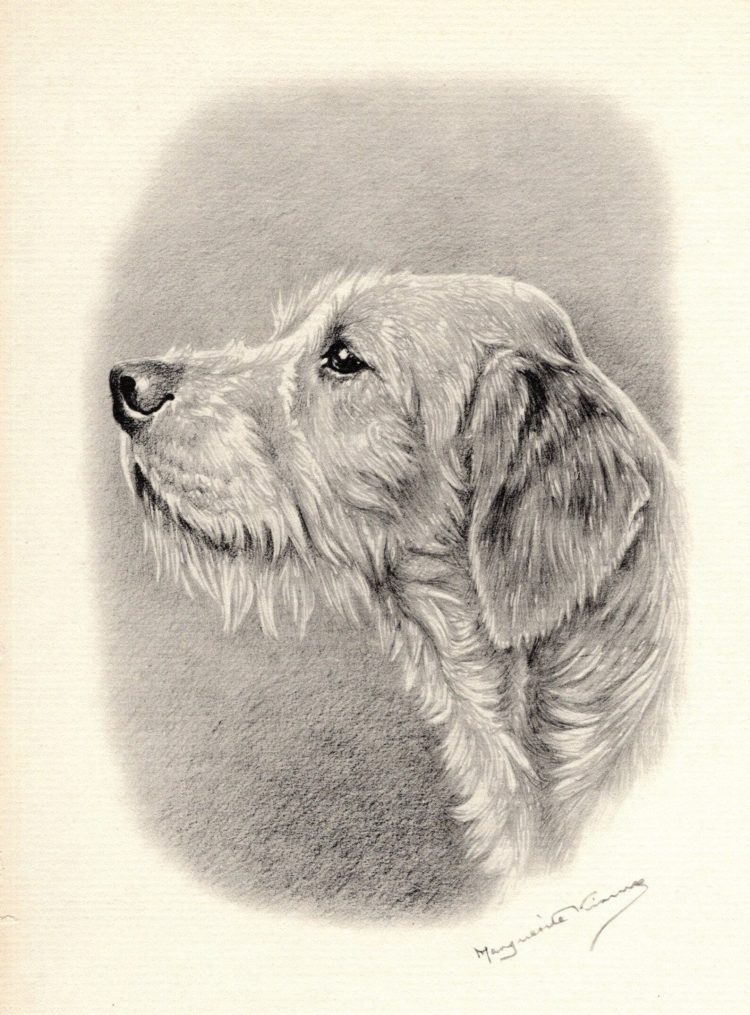
Can you identify this breed based on the following description? (we’re betting you can’t)
- It hovers around 24 inches tall, and usually weighs between 70 to 75 pounds;
- The dog’s skull should be a little domed a little, but he has a full, broad cranium with a fairly defined stop. His muzzle is of moderate length, and it’s “cut” square and straight;
- These chaps have relatively low-set, long ears set close to the head, and they are essentially non-erect;
- They have tight, round feet, well padded and strong!
- His tail is high-set, and while it shouldn’t curl over his back, the dog should carry it in a cheerful manner. The breed’s UKC breed standard states that the tail should be “carried gaily;”
- These dogs have a tireless, free-striding gait that underscores a talent for galloping with a strong drive absent of a rolling gait.
- They can be black, fawn, red, tan, white or mixed, and at the end of the day, there are few disqualifications beyond being cryptorchid, vicious or shy, and having an under or over shot bite.
NPDD has savvy readers, so don’t take offense that we betted against your ability to identify the breed. It’s more a reflection of a rather generic description for a rare breed than it is a reflection of our audience’s dog knowledge. In fact, anyone who narrowed the mystery breed down to being a hound gets a hat tip!
Enough mystery. We’ve just shared with you a thumbnail sketch of the Welsh Bytheuad, also known as the Welsh Foxhound, or simply the Welsh Hound (Bytheuad is Welsh for hound). This is an ancient breed some believe to be descended from the now extinct Celtic Hound that existed in Wales since at least the fifth century. Years later, hunters likely crossbred the hounds to smooth-coated ones kept at the Margam Abbey, dogs descended from the original St. Hubert Hound, and perhaps (according to some sources) smooth coated English Staghounds obtained from Parson Jack Russell – well known to be an avid hunter.
This is all true……………unless you rely on a different source. Some cynologists think the Welsh Hound is a direct descendant of the now extinct Segussi breed.
Ultimately, it’s doubtful anyone will ever know the breed’s true origins given its centuries old history, but according to Celtic lore, these dogs were considered a symbol of status and bestowed with high-levels of respect. During the medieval period, the hounds were used to hunt wild boar, particularly in Wales where the dogs were well-suited to the rough and dense terrain, and good hunters earned respect. From Wikipedia: “From medieval times through the early part of the 20th century, the bards, who had always held a special place in Welsh society, sang odes to the hounds, often naming individual hounds, and praising their qualities. “The ancient laws of Wales codified during the reign of Hywel Dda (942 – 948 AD) give the value of the Welsh Hound as 240 pence trained, 120 pence untrained. By comparison a sound pack horse was valued at the same time as 120 pence.”
We do know that the official studbook for the Welsh Hound was opened by the Welsh Hound Association in 1922 under the presidency of Sir Edward Curre, its expressed purpose to preserve and promoting the Welsh Foxhound as a specific British breed.
At first, the Hounds were selected by type, rather than pedigree, but by 1928, proposals were made to amend the criteria for stud book entry because of a bit of fuss over the breed’s characteristics, particularly of cross-bred hounds (hound “nerds” may enjoy investigating some of those early papers) Since then, the ancestry of individual hound have been more carefully considered, and a specially appointed committee inspects kennels to assess the hounds for their suitability for registration in the stud book.
In what is good news for a working hound, the stud book contained over 900 entries for Welsh Hounds as of 1997 – all of them in hunting packs, and none as privately owned pets. Translation: As we see it, the hounds get to do what they were bred to do, and thus maintain their working instincts.
That said, England outlawed fox hunting and the Welsh Hound, purebred since 1928, had to be reclassified as a rare breed companion or pet rather than an actual working breed. To its credit, the Association does promote the breed through its annual show once integral to the Royal Welsh Agricultural Society Show. It became part of the Wales and Border Counties Hound Show held at Builth Wells show grounds since 1970, and how fun that individual hunts arrange village shows where neighboring packs compete against each other!
As for the breed, itself, the Welsh Hound is described as a sturdy, happy, independent and self reliant hound who is loyal to his family (some say the breed isn’t a good house pet), and an intelligent companion. These dogs were bred to hunt with speed, stamina and vocalizations – and indeed, the breed is used for drag hunting today. The Hounds are expected to be responsive to their huntsman’s voice and are a little famous for ‘talking’ to the huntsman with various howls and barks signalling the progress of the hunt. One source went on to say that with it striking elegance and natural grace, the Welsh Hound is the “Pride and Prejudice” of Purebred Dogs, a moniker we liked enough to use as this post’s title.
We came across a YouTube video which shares more images of this breed:
The United Kennel Club recognized the breed in 2006.
Image: Welsh Foxhound print by Marguerite Kirmse from 1938 is available for purchase from Ginny, owner of plaindealing
